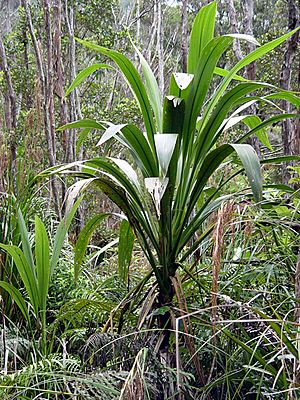Forest cabbage tree facts for kids
Quick facts for kids Forest cabbage tree |
|
|---|---|
 |
|
| Cordyline banksii, Kauaeranga Valley | |
| Scientific classification | |
 |
|
| Natural range of C. banksii | |
| Synonyms | |
|
Cordyline diffusa Colenso. |
Cordyline banksii is a special tree that only grows in New Zealand. It is also known as the forest cabbage tree or tī ngahere (tee NGAH-heh-reh) in the Māori language. This tree is a type of monocot, which means its seeds have one leaf when they first sprout. The name banksii comes from an old botanist named Joseph Banks.
Contents
Where Does the Forest Cabbage Tree Grow?

The forest cabbage tree is quite tough! It can grow in many different places. You can find it in forests near the coast, in low-lying areas, and on lower parts of mountains in the North Island. It is also common in the northern part of the South Island and in Westland, reaching as far south as Haast.
Sometimes, people have reported seeing it in coastal Fiordland, but these sightings have not been fully confirmed. You might also find it in very high, cold areas (called subalpine regions) in the South Island. In areas with lots of shrubs, it can grow alongside another cabbage tree called Cordyline pumilio. Sometimes, these two types of trees can even mix and create new kinds of plants!
What Does the Forest Cabbage Tree Look Like?
The tī ngahere is a tall tree that does not have many branches. It can grow up to 4 metres (13 ft) (about 13 feet) high. Its leaves are shaped like a paddle, or a lance. They can be very long, up to 2 metres (6 ft 7 in) (about 6.5 feet) in length. The leaves are usually between 40–80 millimetres (1.6–3.1 in) (about 1.5 to 3 inches) wide.
The widest part of the leaf is in the middle, and from there, the leaves gently droop downwards. Each leaf has a strong, flat line running down its middle, called a midrib. When the tree produces fruit, it grows a large flower stalk (called a panicle) that can be up to 2 metres (6 ft 7 in) long. The flowers are white and have a lovely smell. The fruits are round, about 5 millimetres (0.20 in) (less than a quarter inch) across, and can be white, bluish-white, or blue.
Is the Forest Cabbage Tree in Danger?
Good news! The Cordyline banksii is not considered to be in danger. Unlike its cousin, Cordyline australis (the common cabbage tree), it seems to be strong against a plant sickness called "sudden decline." This disease is caused by a tiny living thing called a phytoplasma. So, the forest cabbage tree is doing well!
Can You Grow a Forest Cabbage Tree?
Yes, Cordyline banksii is quite easy to grow! If you plant fresh seeds, they will sprout easily. You can also take cuttings from the stems, trunk, or shoots, and they will grow roots quickly.
This tree is not as common in gardens as C. australis, but you can still find it at many plant nurseries and garden centers. Sometimes, you can even buy special types with purple leaves! This tree is great for planting on steep hills or in places where the ground does not drain water very well. It is a hardy plant, meaning it can survive in many different climates.

